Throughput and Delay Scaling of General Cognitive Networks
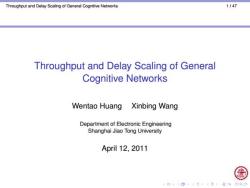
Throughput and Delay Scaling of General Cognitive Networks 1/47 Throughput and Delay Scaling of General Cognitive Networks Wentao Huang Xinbing Wang Department of Electronic Engineering Shanghai Jiao Tong University April 12,2011 4口“③·4E4色卡21=
Throughput and Delay Scaling of General Cognitive Networks 1 / 47 Throughput and Delay Scaling of General Cognitive Networks Wentao Huang Xinbing Wang Department of Electronic Engineering Shanghai Jiao Tong University April 12, 2011

Throughput and Delay Scaling of General Cognitive Networks 2147 Outline Introduction Backgrounds Motivation and Result System Models Basic Models Operation Rules The Hybrid Protocol Model Definition Feasibility Transmission Opportunities Cell Partitioning Round-Robin Mode Independent Relay Mode Optimal Performance Scaling 4口40·4E,4色下空引=
Throughput and Delay Scaling of General Cognitive Networks 2 / 47 Outline Introduction Backgrounds Motivation and Result System Models Basic Models Operation Rules The Hybrid Protocol Model Definition Feasibility Transmission Opportunities Cell Partitioning Round-Robin Mode Independent Relay Mode Optimal Performance Scaling

Throughput and Delay Scaling of General Cognitive Networks 3147 LIntroduction Outline Introduction Backgrounds Motivation and Result System Models Basic Models Operation Rules The Hybrid Protocol Model Definition Feasibility Transmission Opportunities Cell Partitioning Round-Robin Mode Independent Relay Mode Optimal Performance Scaling 4口4·4E,4色F主1=月QC
Throughput and Delay Scaling of General Cognitive Networks 3 / 47 Introduction Outline Introduction Backgrounds Motivation and Result System Models Basic Models Operation Rules The Hybrid Protocol Model Definition Feasibility Transmission Opportunities Cell Partitioning Round-Robin Mode Independent Relay Mode Optimal Performance Scaling

Throughput and Delay Scaling of General Cognitive Networks 4147 LIntroduction LBackgrounds Cognitive Networks Primary users(with priority)and secondary users (opportunistic). A A Form two networks overlapping in all dimensions. spatial,temporal,spectral Both networks could be arbitrary A ad hoc networks. Primary User Secondary User What is the throughput and delay performance of the primary and secondary networks? 口94三卡4老卡2引马
Throughput and Delay Scaling of General Cognitive Networks 4 / 47 Introduction Backgrounds Cognitive Networks I Primary users (with priority) and secondary users (opportunistic). I Form two networks overlapping in all dimensions. I spatial, temporal, spectral I Both networks could be arbitrary ad hoc networks. What is the throughput and delay performance of the primary and secondary networks?
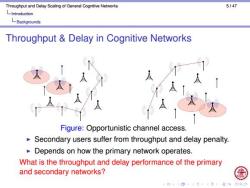
Throughput and Delay Scaling of General Cognitive Networks 5147 LIntroduction LBackgrounds Throughput Delay in Cognitive Networks Figure:Opportunistic channel access. Secondary users suffer from throughput and delay penalty. Depends on how the primary network operates. What is the throughput and delay performance of the primary and secondary networks?
Throughput and Delay Scaling of General Cognitive Networks 5 / 47 Introduction Backgrounds Throughput & Delay in Cognitive Networks Figure: Opportunistic channel access. I Secondary users suffer from throughput and delay penalty. I Depends on how the primary network operates. What is the throughput and delay performance of the primary and secondary networks?
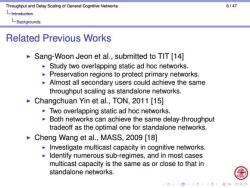
Throughput and Delay Scaling of General Cognitive Networks 6/47 LIntroduction LBackgrounds Related Previous Works Sang-Woon Jeon et al.,submitted to TIT [14] Study two overlapping static ad hoc networks. Preservation regions to protect primary networks. Almost all secondary users could achieve the same throughput scaling as standalone networks. Changchuan Yin et al.,TON,2011 [15] Two overlapping static ad hoc networks. Both networks can achieve the same delay-throughput tradeoff as the optimal one for standalone networks. Cheng Wang et al.,MASS,2009 [18] Investigate multicast capacity in cognitive networks. Identify numerous sub-regimes,and in most cases multicast capacity is the same as or close to that in standalone networks. 4口4·4E,4色空1=
Throughput and Delay Scaling of General Cognitive Networks 6 / 47 Introduction Backgrounds Related Previous Works I Sang-Woon Jeon et al., submitted to TIT [14] I Study two overlapping static ad hoc networks. I Preservation regions to protect primary networks. I Almost all secondary users could achieve the same throughput scaling as standalone networks. I Changchuan Yin et al., TON, 2011 [15] I Two overlapping static ad hoc networks. I Both networks can achieve the same delay-throughput tradeoff as the optimal one for standalone networks. I Cheng Wang et al., MASS, 2009 [18] I Investigate multicast capacity in cognitive networks. I Identify numerous sub-regimes, and in most cases multicast capacity is the same as or close to that in standalone networks

Throughput and Delay Scaling of General Cognitive Networks 7147 LIntroduction LMotivation and Result Motivation All previous works consider specific primary networks with predefined communication schemes,and then design secondary protocols accordingly. But primary networks could be arbitrary and diverse. All report similar or same results as standalone networks. May imply a stronger and more general conclusion exists. Figure:Various kinds of primary users in White Spaces networks. 4口4·4E,4色下空1
Throughput and Delay Scaling of General Cognitive Networks 7 / 47 Introduction Motivation and Result Motivation I All previous works consider specific primary networks with predefined communication schemes, and then design secondary protocols accordingly. I But primary networks could be arbitrary and diverse. I All report similar or same results as standalone networks. I May imply a stronger and more general conclusion exists. Figure: Various kinds of primary users in White Spaces networks
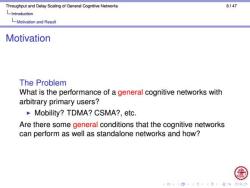
Throughput and Delay Scaling of General Cognitive Networks 8147 LIntroduction LMotivation and Result Motivation The Problem What is the performance of a general cognitive networks with arbitrary primary users? Mobility?TDMA?CSMA?,etc. Are there some general conditions that the cognitive networks can perform as well as standalone networks and how? 4口“0·4E4色t1=月QC
Throughput and Delay Scaling of General Cognitive Networks 8 / 47 Introduction Motivation and Result Motivation The Problem What is the performance of a general cognitive networks with arbitrary primary users? I Mobility? TDMA? CSMA?, etc. Are there some general conditions that the cognitive networks can perform as well as standalone networks and how?
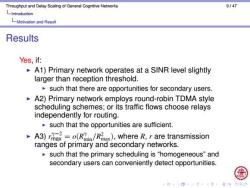
Throughput and Delay Scaling of General Cognitive Networks 9147 LIntroduction LMotivation and Result Results Yes,if: A1)Primary network operates at a SINR level slightly larger than reception threshold. such that there are opportunities for secondary users. A2)Primary network employs round-robin TDMA style scheduling schemes;or its traffic flows choose relays independently for routing. such that the opportunities are sufficient. A3)rma=o(Rin/R),where R,r are transmission ranges of primary and secondary networks. such that the primary scheduling is "homogeneous"and secondary users can conveniently detect opportunities. 4口40·4E,4色下空1=
Throughput and Delay Scaling of General Cognitive Networks 9 / 47 Introduction Motivation and Result Results Yes, if: I A1) Primary network operates at a SINR level slightly larger than reception threshold. I such that there are opportunities for secondary users. I A2) Primary network employs round-robin TDMA style scheduling schemes; or its traffic flows choose relays independently for routing. I such that the opportunities are sufficient. I A3) r γ−2 max = o(R γ min/R 2 max), where R, r are transmission ranges of primary and secondary networks. I such that the primary scheduling is “homogeneous” and secondary users can conveniently detect opportunities

Throughput and Delay Scaling of General Cognitive Networks 10/47 LSystem Models Outline Introduction Backgrounds Motivation and Result System Models Basic Models Operation Rules The Hybrid Protocol Model Definition Feasibility Transmission Opportunities Cell Partitioning Round-Robin Mode Independent Relay Mode Optimal Performance Scaling 4口140·4E4色F1=月QC
Throughput and Delay Scaling of General Cognitive Networks 10 / 47 System Models Outline Introduction Backgrounds Motivation and Result System Models Basic Models Operation Rules The Hybrid Protocol Model Definition Feasibility Transmission Opportunities Cell Partitioning Round-Robin Mode Independent Relay Mode Optimal Performance Scaling
按次数下载不扣除下载券;
注册用户24小时内重复下载只扣除一次;
顺序:VIP每日次数-->可用次数-->下载券;
- Determining Source-Destination Connectivity in Uncertain Networks:Modeling and Solutions.pdf
- Joint Optimization of Multicast Energy in Delay-constrained Mobile Wireless Networks.pdf
- FINE:A Framework for Distributed Learning on Incomplete Observations for Heterogeneous Crowdsensing Networks.pdf
- A Distributed Algorithm to Construct Multicast Trees in WSNs:An Approximate Steiner Tree Approach.pptx
- Distributed Multicast Tree Construction in Wireless Sensor Networks.pdf
- Coded Caching under Arbitrary Popularity Distributions.pptx
- Coded Caching under Arbitrary Popularity Distributions.pdf
- On the Similarity between von Neumann Graph Entropy and Structural Information:Interpretation, Computation, and Applications.pdf
- 中国科学技术大学:《数据结构及其算法》课程教学资源(课件讲稿)第12章 文件.pdf
- 中国科学技术大学:《数据结构及其算法》课程教学资源(课件讲稿)第8章 动态存储管理.pdf
- 中国科学技术大学:《数据结构及其算法》课程教学资源(课件讲稿)第9章 查找.pdf
- 中国科学技术大学:《数据结构及其算法》课程教学资源(课件讲稿)第5章 广义表.pdf
- 中国科学技术大学:《数据结构及其算法》课程教学资源(课件讲稿)第7章 图.pdf
- 中国科学技术大学:《数据结构及其算法》课程教学资源(教案讲义)第7章 图(图的遍历算法及其应用).doc
- 中国科学技术大学:《数据结构及其算法》课程教学资源(课件讲稿)第6章 树和二叉树.pdf
- 中国科学技术大学:《数据结构及其算法》课程教学资源(教案讲义)第6章 树和二叉树.doc
- 中国科学技术大学:《数据结构及其算法》课程教学资源(教案讲义)第4章 串、数组和广义表.doc
- 中国科学技术大学:《数据结构及其算法》课程教学资源(课件讲稿)第4章 串.pdf
- 中国科学技术大学:《数据结构及其算法》课程教学资源(教案讲义)第3章 栈和队列.doc
- 中国科学技术大学:《数据结构及其算法》课程教学资源(课件讲稿)第3章 栈和队列.pdf
- Heterogeneity Increases Multicast Capacity In Clustered Network.ppt
- Mobility Increases the Connectivity of K-hop Clustered Wireless Networks.ppt
- Fundamental Relationship between Node Density and Delay in Wireless Ad Hoc Networks with Unreliable Links.ppt
- MotionCast:On the Capacity and Delay Tradeoffs.ppt
- Optimal Determination of Source-destination Connectivity in Random Graphs.ppt
- Coverage and Energy Consumption Control in Mobile Heterogeneous Wireless Sensor Networks.pdf
- DRIMUX:Dynamic Rumor Influence Minimization with User Experience in Social Networks.pdf
- Achieving 100% Throughput in TCP/AQM Under Aggressive Packet Marking With Small Buffer.pdf
- Delay and Capacity Tradeoff Analysis for MotionCast.pdf
- Multicast Performance With Hierarchical Cooperation.pdf
- Capacity Scaling of General Cognitive Networks.pdf
- Mobility Increases the Connectivity of Wireless Networks.pdf
- Asymptotic Analysis on Secrecy Capacity in Large-Scale Wireless Networks.pdf
- Asymptotic Analysis on Secrecy Capacity in Large-Scale Wireless Networks.ppt
- Multicast Capacity with Max-Min Fairness for Heterogeneous Networks.pdf
- Node Density and Delay in Large-Scale Wireless Networks with Unreliable Links.pdf
- Two-Dimensional Route Switching in Cognitive Radio Networks:A Game-Theoretical Framework.pdf
- Two-Dimensional Route Switching in Cognitive Radio Networks:A Game-Theoretical Framework.ppt
- Optimal Secrecy Capacity-Delay Tradeoff in Large-Scale Mobile Ad Hoc Networks.pdf
- Impact of Social Relation and Group Size in Multicast Ad Hoc Networks.pdf
